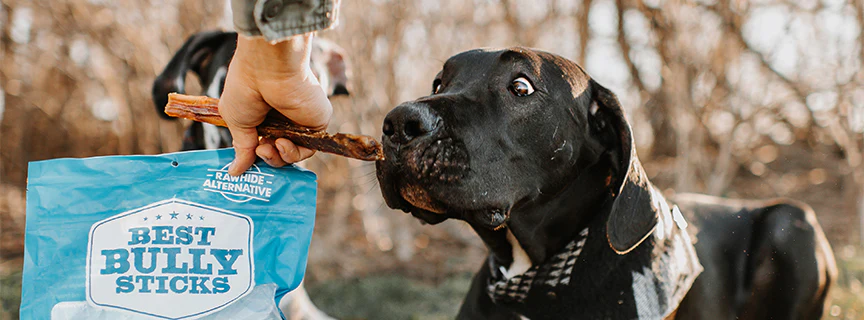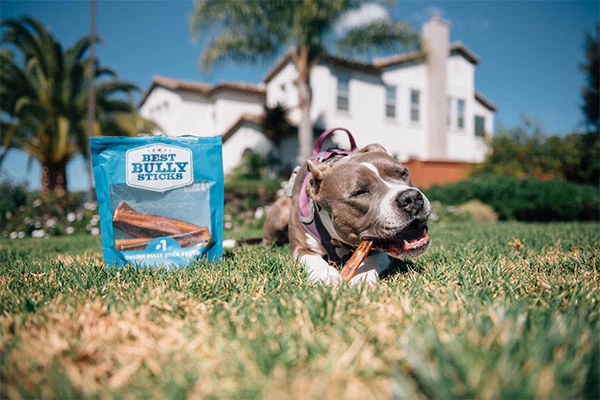How Many Bully Sticks Can a Dog Have?
Looking for the ideal treat for your dog? Bully sticks are a popular choice due to their benefits and long-lasting nature. This guide covers what bully sticks are, their advantages, and how to gauge the right quantity for your dog.
We’ll also discuss the frequency of giving these treats and answer common questions about bully sticks, helping you make informed choices for your pet’s health and happiness.
Key takeaways
Bully sticks are a popular dog treat due to their long-lasting nature and various health benefits.
The number of bully sticks a dog can have depends on factors like size, weight, and dietary needs.
Overconsumption of bully sticks can lead to issues like obesity and digestion problems.
As a rule of thumb, dogs should not consume more than one bully stick per day.
Always supervise your dog while they’re enjoying a bully stick to prevent choking hazards.
What are Bully Sticks?
Origin and Composition
Bully sticks, also known as pizzle sticks or beef pizzles, are made from the dried, uncooked penile tissue of bulls or steers. They are 100% natural, single-ingredient chews that are high in protein and low in fat, making them a healthy option for many dogs. They are often marketed as an alternative to beef hide.
Nutritional Benefits
In addition to being high in protein, bully sticks also provide essential nutrients like amino acids, vitamins, and minerals. These nutrients support your dog’s muscle development, overall energy levels, and immune system function.
Different Sizes and Types
Bully sticks come in various sizes, thicknesses, and shapes to accommodate dogs of all sizes and chewing habits. From thin, braided, or straight sticks to thick, curly, or ring-shaped varieties, there’s a bully stick out there for every dog.
Why Dogs Love Bully Sticks

Natural Chewing Instincts
Dogs have a natural instinct to chew, which helps alleviate boredom, anxiety, and excess energy. Bully sticks provide an outlet for this instinct while satisfying your dog’s need for a tasty treat.
Dental Health Benefits
Chewing on bully sticks helps to remove plaque and tartar from your dog’s teeth, promoting better oral hygiene and reducing the risk of dental issues like gum disease and tooth decay.
Long-lasting and Satisfying
Compared to other dog chews, bully sticks tend to last longer, providing hours of enjoyment for your dog. The chewy texture and natural flavor make them an irresistible and satisfying treat.
How to Determine the Appropriate Quantity of Bully Sticks for Your Dog

1. Consider Your Dog’s Size and Weight
Smaller dogs may require thinner, shorter bully sticks, while larger dogs may need thicker, longer ones. Monitor your dog’s weight and adjust the quantity accordingly to prevent weight gain.
2. Take into Account Your Dog’s Activity Level
Active dogs may require more frequent or larger bully sticks to support their energy needs, while less active dogs may require smaller portions or fewer chews to prevent excess calories.
3. Assess Your Dog’s Chewing Habits and Preferences
Observe how your dog interacts with bully sticks – do they devour them quickly, or do they savor the treat over a longer period? Tailor the size, shape, and quantity based on your dog’s unique chewing style.
4. Monitor for Any Health Issues or Dietary Restrictions
If your dog has specific health issues or dietary restrictions, consult your veterinarian to determine the appropriate quantity and frequency of bully sticks for your pet.
How Often Should Your Dog Have Bully Sticks?
General Guidelines for Frequency
As a rule of thumb, it’s recommended to give your dog one bully stick per day or every other day. However, it’s crucial to consider factors like your dog’s size, weight, activity level, and overall health when determining the appropriate frequency.
Factors that Influence Frequency
1. Treats and Rewards System
If you’re using bully sticks as a reward for good behavior or training purposes, you may need to adjust the frequency accordingly. Remember to balance the total number of treats your dog receives daily, ensuring that they don’t exceed 10% of their daily calorie intake.
2. Balancing with Other Chews and Treats
If your dog enjoys a variety of chews and treats, make sure to adjust the frequency of bully sticks to maintain a balanced diet. Too many high-protein chews can cause digestive issues, so moderation is key.
Importance of Moderation
Overindulging your dog with bully sticks can lead to weight gain and other health issues. Monitoring and adjusting the frequency of bully sticks based on your dog’s needs will help ensure they enjoy these treats in a healthy and sustainable manner.
Proper Supervision and Safety Precautions
Supervising Your Dog While Enjoying Bully Sticks
Always supervise your dog when they’re chewing on bully sticks to ensure their safety. This helps to prevent choking hazards, especially when the chew becomes too small.
Choosing the Appropriate Size and Type for Your Dog
Select bully sticks that are appropriate for your dog’s size, weight, and chewing habits. This not only ensures a safe chewing experience but also maximizes the enjoyment and benefits your dog gets from the treat.
When to Replace or Remove a Bully Stick
Replace or remove the bully stick once it becomes small enough to pose a choking hazard or if it shows signs of excessive wear or damage.
Environmentally Conscious Bully Stick Choices
Sustainable and Ethical Sourcing
Look for bully stick brands that prioritize sustainable and ethical sourcing practices. This helps to support humane treatment of animals and reduce the environmental impact of their production.
Natural and Chemical-Free Options
Choose bully sticks made from all-natural ingredients without any added chemicals, preservatives, or artificial colors. This ensures a healthier and safer treat for your dog.
Supporting Small, Local Businesses
Consider purchasing bully sticks from local or small-scale producers who prioritize quality, sustainability, and ethical practices. This supports local businesses and helps to reduce the carbon footprint associated with transporting and distributing these treats.
Frequently Asked Questions
Can puppies have bully sticks?
Yes, puppies can have bully sticks, but it’s important to choose the appropriate size and supervise their chewing.
Can bully sticks cause diarrhea or other digestive issues?
Overconsumption of bully sticks can cause digestive issues. It’s important to introduce them slowly and monitor your dog’s reaction.
Are there any alternatives to bully sticks for dogs with dietary restrictions?
Yes, there are several alternatives like sweet potato chews or fish skin treats that can cater to dogs with specific dietary restrictions.
Can I give bully sticks to my small dog?
Absolutely! Just make sure to choose the right size and thickness for your small dog and supervise their chewing.
How should I store bully sticks?
Store bully sticks in a cool, dry place away from direct sunlight to maintain their freshness and prevent spoilage.
Can my dog have too many bully sticks?
Yes, too many bully sticks can lead to weight gain and other health issues. It’s important to follow the recommended guidelines and monitor your dog’s overall health.
Final Thoughts
By understanding what bully sticks are, their benefits, and the factors that determine the appropriate quantity and frequency for your dog, you can help ensure their health and well-being while indulging them with this delicious and satisfying treat.
Remember that moderation is key, and always supervise your dog when they enjoy a bully stick. With the right balance, your furry friend can safely enjoy the numerous benefits of bully sticks as part of their daily routine.






